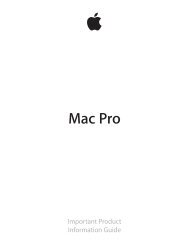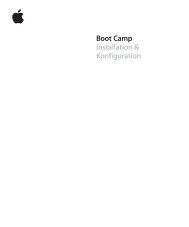iPhone User Guide - Support - Apple
iPhone User Guide - Support - Apple
iPhone User Guide - Support - Apple
Create successful ePaper yourself
Turn your PDF publications into a flip-book with our unique Google optimized e-Paper software.
Update and restore <strong>iPhone</strong> software<br />
About update and restore<br />
You can update <strong>iPhone</strong> software in Settings, or by using iTunes. You can also erase or restore<br />
<strong>iPhone</strong>, and then use iCloud or iTunes to restore from a backup.<br />
Update <strong>iPhone</strong><br />
You can update software in <strong>iPhone</strong> Settings or by using iTunes.<br />
Update wirelessly on <strong>iPhone</strong>. Go to Settings > General > Software Update. <strong>iPhone</strong> checks for<br />
available software updates.<br />
Update software in iTunes. iTunes checks for available software updates each time you sync<br />
<strong>iPhone</strong> using iTunes. See Sync with iTunes on page 18.<br />
For more information about updating <strong>iPhone</strong> software, see support.apple.com/kb/HT4623.<br />
Restore <strong>iPhone</strong><br />
You can use iCloud or iTunes to restore <strong>iPhone</strong> from a backup.<br />
Restore from an iCloud backup. Reset <strong>iPhone</strong> to erase all settings and information, then sign<br />
in to iCloud and choose “Restore from a Backup” in the Setup Assistant. See Restart or reset<br />
<strong>iPhone</strong> on page 150.<br />
Restore from an iTunes backup. Connect <strong>iPhone</strong> to the computer you normally sync with, select<br />
<strong>iPhone</strong> in the iTunes window, then click Restore in the Summary pane.<br />
When the <strong>iPhone</strong> software is restored, you can either set it up as a new <strong>iPhone</strong>, or restore your<br />
music, videos, app data, and other content from a backup.<br />
For more information about restoring <strong>iPhone</strong> software, see support.apple.com/kb/HT1414.<br />
Cellular settings<br />
Use Cellular settings to turn cellular data and roaming on or off, set which apps and services use<br />
cellular data, see call time and cellular data usage, and set other cellular options.<br />
If <strong>iPhone</strong> is connected to the Internet via the cellular data network, the , , , , or<br />
icon appears in the status bar.<br />
LTE, 4G, and 3G service on GSM cellular networks support simultaneous voice and data<br />
communications. For all other cellular connections, you can’t use Internet services while you’re<br />
talking on the phone unless <strong>iPhone</strong> also has a Wi-Fi connection to the Internet. Depending on<br />
your network connection, you may not be able to receive calls while <strong>iPhone</strong> transfers data over<br />
the cellular network—when downloading a webpage, for example.<br />
••<br />
GSM networks: On an EDGE or GPRS connection, incoming calls may go directly to voicemail<br />
during data transfers. For incoming calls that you answer, data transfers are paused.<br />
••<br />
CDMA networks: On EV-DO connections, data transfers are paused when you answer incoming<br />
calls. On 1xRTT connections, incoming calls may go directly to voicemail during data transfers.<br />
For incoming calls that you answer, data transfers are paused.<br />
Data transfer resumes when you end the call.<br />
Appendix D Safety, Handling, & <strong>Support</strong> 153
















